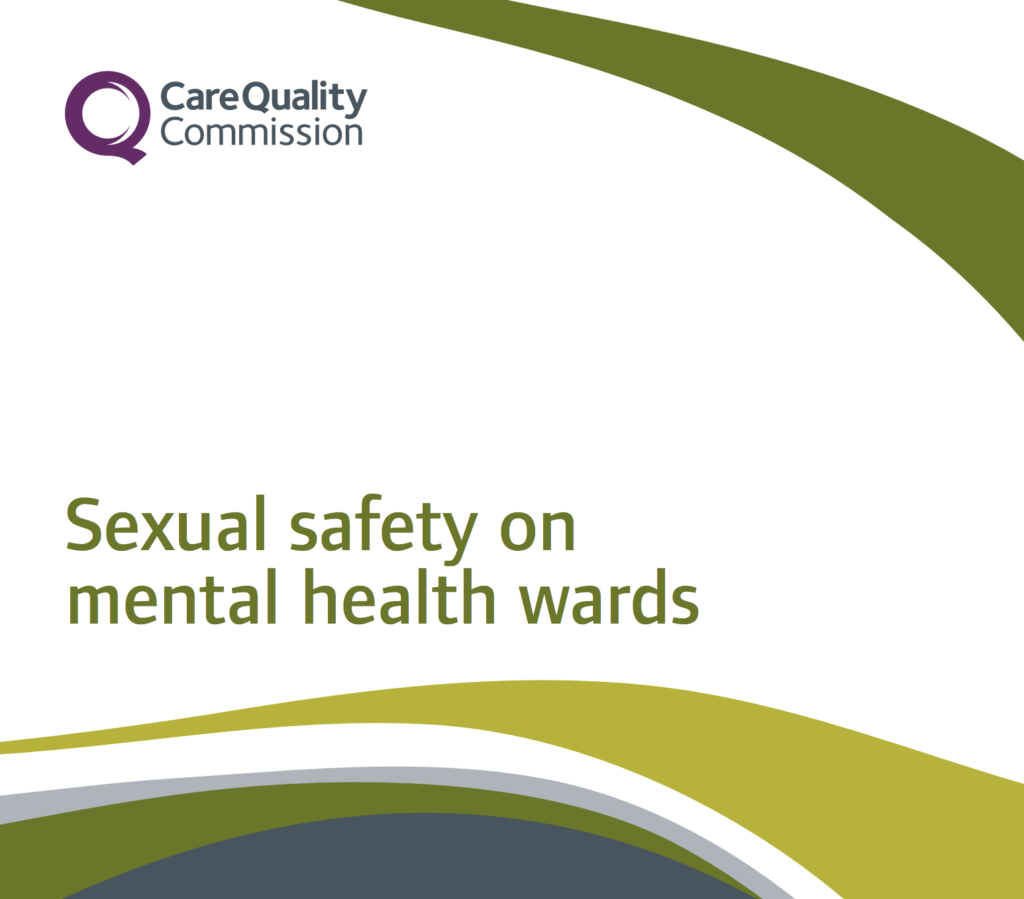
People who are mentally unwell, and at risk of harming themselves or others, need a place of safety and respite in order to recover. The purpose of an admission to a mental health unit should be to recover and be safe. However, the reality is often very different. Vacant beds are often in short supply and delays to admission can mean that the people who get admitted are extremely unwell. Admissions under the Mental Health Act continue to rise. Wards are often perceived as challenging places to be and many service users report feeling unsafe.
Recently the Care Quality Commission have become concerned about “sexual safety” following reports of allegations of serious sexual assaults made by patients during routine inspections. This blog aims to discuss what we know about “sexual safety” in mental health settings but primarily to focus on the CQC report.

The Care Quality Commission have published a new report today entitled: Sexual Safety on Mental Health Wards.
Sexual safety
There are two main issues with regard to “sexual safety”:
- Behaviour that falls into the realms of a sexual offence, such as sexual assault and rape (these are criminal offences).
- “Inappropriate sexual behaviour” (ISB), which encompasses a wide range of behaviour, including “suggestive language, flirtation, fondling, removing one’s clothing, and masturbating in public” (Mania et al, 2006).
However, in defining what is and isn’t appropriate, the context in which they occur needs to be taken into account, and the extent to which these behaviours interfere with every day functioning, and how much distress or discomfort they are causing others. For instance, suggestive language, flirtation, and touching in the context of two consenting adults who are forming (or in) a sexual relationship would be entirely appropriate, however, it would be considered inappropriate if it was enacted towards a member of staff on the ward. ISB manifested as a consequence of disinhibition and/or hyper-sexuality can sometimes accompany acute periods of mental illness such as bipolar affective disorder and psychosis. It is also not restricted to mental illness; ISB can be exhibited in people with cognitive impairments such as dementia (Cipriani et al, 2015).

Sexual safety encompasses a wide range of behaviours, from “inappropriate sexual behaviour” to criminal offences like assault and rape.
The CQC report: Sexual Safety on Mental Health Wards
The CQC undertook an investigation into sexual incidents over a three month period between April to June 2017. Data from records in the National Reporting and Learning System for 52 NHS Trusts that provided inpatient care were text-mined for keywords related to sexual incidents. This included text related to sexual assaults, sexual harassment and sexualised behaviour. They also included incidents of exposure (where people were naked or had exposed their genitals) as this was also deemed to be distressing for those who witnessed it. They also included incidents even if they had deemed to be consensual (as it was not clear if an assessment of capacity to consent had been undertook and therefore possible that some of these incidents may not have been consensual).
The CQC also held four engagement events to discuss these findings with a range of stakeholders including healthcare professionals, service users and carers.
The National Reporting and Learning System was text-mined for keywords related to sexual incidents.
Results
- Of 60,000 incidents over the three month period, 1,120 incidents were deemed to be related to sexual safety (which is 1.6%)
- The most commonly recorded incident (26.5% of the total related to sexual safety) was nakedness or exposure (n=298)
- Under a quarter (24.4% of the total) were recorded as “sexual assault” (n=273)
- 2.6% were allegations of rape (n=29)
- The alleged incidents were undertaken by patients. However, some reports concerned allegations against staff members
- Many of the incidents (n=410) took place in communal areas. The actions taken as a result of these incidents were missing for about the third of the incident descriptions. Where this information was present, a wide range of responses were recorded, the most common being:
- Removal of the person from the situation
- Discussion about behaviour
- Medication offered
- Containment/restraint of the person
- Overall 97% of the 1,120 incidents were graded as “no risk/low risk”. It is important to note that the CQC followed up on all serious allegations to ensure that appropriate action had been taken in those services.
Conclusion and recommendations
The CQC report does acknowledge the limitations of analysis of routine data, but rightly concludes that this report should stimulate further discussions about sexual safety on inpatient units.

This report should stimulate further discussions about sexual safety on inpatient units.
Discussion
Whilst the vast majority of incidents are “low risk”; there is a need to take seriously the allegations of sexual assault and rape by people with mental health problems in inpatient settings. The findings of the CQC report concur with an earlier research study undertaken by Bowers et al (2014), which reported on a prospective study of sexual incidents over a period of 2 weeks following admission to 84 wards across 31 NHS mental health services. There were a total of 147 sexual incidents, and the most common incidents were exposure and public masturbation. Bowers et al found no difference in rates of any sexual incidents between same sex and single sex wards, and many of the incidents occurred in communal areas rather than bedrooms or bathrooms.
However, it is also important to consider that sexual assault can also occur in the community. Brooker and Durmaz (2015) undertook a survey of sexual assault referral centres and found that 40% of people attending Sexual Assault Referral Centres were already known to mental health services. Evidence suggests that mental health staff are reluctant to discuss sex and sexual assault. Brooker et al 2016 found that questions regarding sexual assault were largely omitted in CPA (Care Programme Approach) reviews. In a focus group study of mental health staff, the participants reported that they would tend to avoid the topic, and that it wasn’t part of routine care (Hughes et al, 2018).

Evidence suggests that mental health staff are reluctant to discuss sex and sexual assault.
Improving the sexual safety of patients and staff
If mental health services want to enhance sexual safety, then initiatives need to focus on community services as well as inpatient settings. We need to be able to:
- Identify the range of sexual behaviours of concern
- Understand the motives and contexts in which they occur
- Develop standard processes for dealing with a whole range of behaviours in a sensitive and proactive manner
- Have a clear mechanism by which patients can report sexual assault, and for appropriate actions to be taken.
The CQC highlight the useful guidelines that have been developed by the government in New South Wales, Australia to improve sexual safety and support patients (Sexual Safety of Mental Health Consumers Guidelines for inpatient settings PDF).
However, I want to end this blog with a word of caution. Firstly it is clear that serious sexual assault is a rare occasion in inpatient settings and its important that there is a balanced reaction to the CQC report. There is also a risk that by raising concerns around sexual safety and becoming more proactive, we may inadvertently curtail patients’ rights to express their sexuality appropriately and to be able to form consensual relationships. Sexuality may even be pathologised and seen as a manifestation of people’s illness.
Many people with mental illness (like most adults) aspire to have safe and supportive sexual relationships (McCann, 2010). This is also true for people incarcerated for longer periods such as forensic mental health settings (Quinn and Happell, 2015). However, because of concerns regarding vulnerability and abuse, mental health staff tend to discourage sexual relationships between patients. It is vital that mental health staff recognise the issues relating to sex and mental health, and have the confidence and skills to bring these conversations into routine assessment and care planning. This openness may well lead to better safeguarding.

It is vital that mental health staff recognise the issues relating to sex and mental health, and have the confidence and skills to bring these conversations into routine assessment and care planning.
Links
Primary paper
Care Quality Commission (2018) Sexual Safety on Mental Health Wards. 11 Sep 2018.
Other references
Bowers, L. , Ross, J. , Cutting, P. and Stewart, D. (2014), Sexual behaviours on acute inpatient psychiatric units. J Psychiatr Ment Health Nurs, 21: 271-279. doi:10.1111/jpm.12080
Brooker C, Durmaz E. (2015) Mental health, sexual violence and the work of Sexual Assault Referral centres (SARCs) in England. Journal of Forensic and Legal Medicine, Volume 31, Pages 47-51.
Brooker C, Tocque K, Kennedy A, Brown M. (2016) The Care Programme Approach, sexual violence and clinical practice in mental health. J Forensic Leg Med 2016;43:97-101.
Cipriani, G. , Ulivi, M. , Danti, S. , Lucetti, C. and Nuti, A. (2016), Sexual disinhibition and dementia. Psychogeriatrics, 16: 145-153. doi:10.1111/psyg.12143
Hughes, E. , Edmondson, A. J., Onyekwe, I. , Quinn, C. and Nolan, F. (2018), Identifying and addressing sexual health in serious mental illness: Views of mental health staff working in two National Health Service organizations in England. Int J Mental Health Nurs, 27: 966-974. doi:10.1111/inm.12402
Mania I, Evcimen H, Mathews M. (2006) Citalopram Treatment for Inappropriate Sexual Behavior in a Cognitively Impaired Patient. Primary Care Companion to The Journal of Clinical Psychiatry. 2006;8(2):106.
McCann E. (2010) Investigating mental health service user views regarding sexual and relationship issues. Journal of Psychiatric and Mental Health Nursing 2010;17:251-9.
Quinn, C. and Happell, B. (2015) Consumer Sexual Relationships in Forensics. Int J Ment Health Nurs, 24: 121-129. doi:10.1111/inm.12112
Definitions
Rape is when a person intentionally penetrates another’s vagina, anus or mouth with a penis, without the other person’s consent.
Assault by penetration is when a person penetrates another person’s vagina or anus with any part of the body other than a penis, or by using an object, without the person’s consent.
Sexual assault is defined as an act of physical, psychological and emotional violation in the form of a sexual act, inflicted on someone without their consent. It can involve forcing or manipulating someone to witness or participate in any sexual acts.
The above definitions are taken from the Metropolitan Police’s What is Rape and Sexual Assault? webpage.
Photo credits
- Photo by Tomas Sobek on Unsplash
- By Chris20060 [CC BY-SA 4.0 ], from Wikimedia Commons
- Photo by Rachel Pfuetzner on Unsplash


My daughter was raped over a period of five months in a mental health hospital. She received no support or even counselling from the trust. She then received explicit messages from a security guard during another admission.It’s disgusting how staff take advantage of vulnerable people.